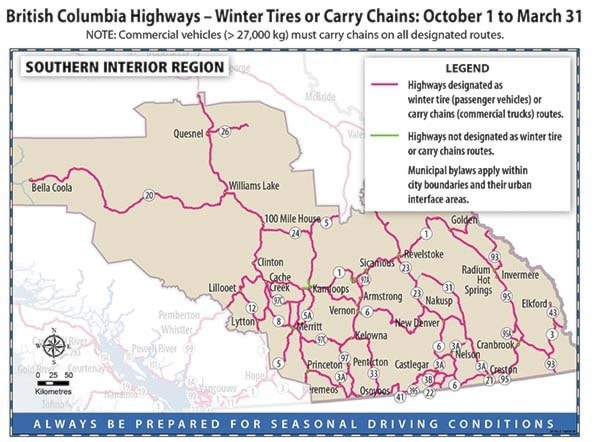We flipped the calendar into October this week and that means it’s time to ready ourselves for winter — put away the hoses, clean up the yards, and get winter tires on the car.
Motorists may have noticed new highway signs installed in the past few weeks — new, larger signs advising motorists that winter tires are required on designated highways.
It is always a question at this time of year as to whether having winter tires is the law. The answer is that it is, and it isn’t.
Signs are posted on each of the designated highways (including out of Kimberley in both directions) to advise motorists where winter tires are required. These are generally located approaching high mountain passes and interior highways where conditions can change from rain to snow very quickly. In the Interior, that is every highway. Highway 95A between Kimberley and Cranbrook requires winter tires, as do Routes 1 and 3.
“You could receive a violation ticket for improper tires,” Cpl. Chris Newel of the Kimberley RCMP.
“It only applies on Provincial Highways and designated areas. Hence the reason the signs are outside the city.”
As a result of the technical analysis completed during the Rural Highway Safety and Speed Review, winter tires have been defined as those labelled with either the winter mountain/snowflake symbol or the mud and snow (M+S) designation. Winter tires must also be in good condition with a minimum tread depth of 3.5 mm.
RCMP, CVSE, and other policing agencies can prevent you from travelling and issue tickets if your vehicle is not properly equipped for road conditions.
However, if you are in an accident, and your vehicle is not equipped with winter tires, that doesn’t automatically mean that your insurance is void.
ICBC advises that driving without winter tires will not void your insurance if you have a claim. It also won’t mean you’re automatically at-fault in a crash. However, if you get in a crash where winter tires could have helped, not having them may affect whether — or how much — you are at fault.
“In the event of a collision police will examine the tires to see if they comply,” Newel said. “Insurance is a separate issue.”
Timing has also changed for winter tires. In previous years the timeframe was October 1 to April 30. The new timeframe is October 1 to March 31.
In the end it comes down to common sense.
“I strongly recommend proper winter tires,” Newel said. “That is those with the mountain/snowflake. Your family’s safety could be riding on your tires.”
